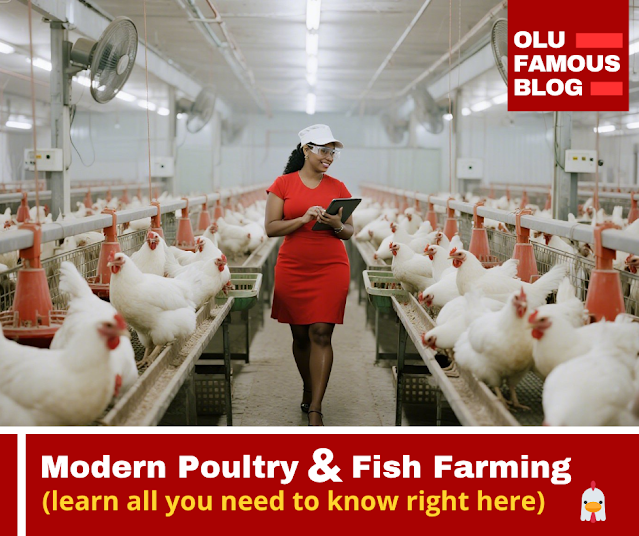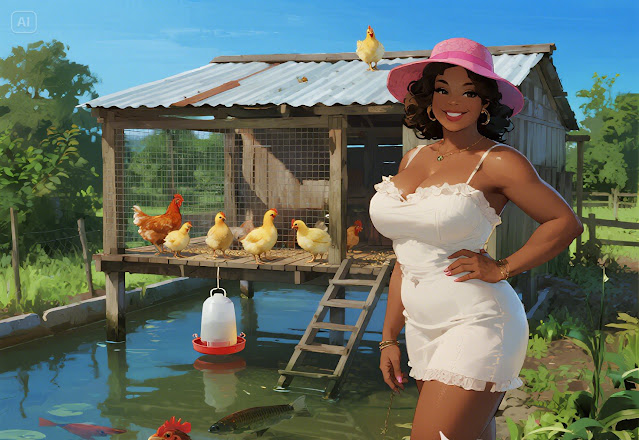Poultry and Fish farming isn’t what it used to be. Back in the day, we farmed with muscle and sweat. But now? It’s the smart way, using latest tools with what you have to get the best results.
Things have changed. Imagine raising chickens right above your fish pond. Their droppings fall directly into the water and serve as nutrients for plankton, which your fish feed on. That’s less waste, less cost, and more gain.
In this complete guide, you will learn how to start from scratch and grow into profit, using the methods I'll be sharing with you. So let’s get into it, step by step.
Understanding the Integration System
The integrated system is quite simple when you understand the concept. You build a raised poultry pen directly above your fish pond. As your chickens eat and excrete, the droppings fall into the pond. These droppings become organic manure for algae and plankton, which in turn feed your fish.
Benefits of this system:
- Cuts down fish feeding cost by up to 30%
- Increases fish growth rate
- Reduces waste and odor
But it must be done properly. The pond must be deep enough and oxygenated. You should use Catfish, as they are hardy and thrive in this system.
Choosing the Right Birds and Fish
For poultry… go for broilers if your goal is meat or layers if you want eggs. Broilers grow fast and drop a lot of manure, which is great for the pond. Layers live longer and can still provide quality manure.
For fish… catfish is my favorite. They’re strong, easy to feed, and can grow big. Tilapia is another good one if you manage your water quality well.
Just don’t overcrowd your pond or poultry. There must be a balance. I usually advise 100 chickens per standard 100-square-meter pond.
Building Your Integrated Setup
Start with the pond. Dig a standard pond – about 4ft to 6ft deep, depending on your land. Concrete ponds are easier to manage for beginners.
Then build a raised poultry pen using wood, wire mesh, and iron sheets for roofing. Make sure it is about 5ft to 6ft above the pond. The floor should be slatted or meshed so droppings fall freely.
Leave enough space between the pond and the poultry for air circulation. Provide ramps or ladders for human access, and use bamboo or treated wood to resist water damage.
Feeding the Birds and Fish
How and what you feed them will go a long way to determine the end gain.
For Poultry:
- Feed chicks starter mash for 3 weeks
- Grower feed for another 3 weeks
- Then finisher feed until they mature
- Add vitamins to their water, and give them clean water daily.
For Fish:
- Let them eat plankton from the chicken droppings
- Supplement with local feeds: ground maize, blood meal, cassava peels
- Or buy floating pellets to help monitor their feeding
🧠 Tip: Don’t overfeed. Watch their behavior. If they stop rushing, stop feeding.
Keeping Them Healthy
Biosecurity is key. Clean the poultry pen weekly. Remove sick birds immediately. Vaccinate your chickens against Newcastle and Gumboro disease.
Watch your fish for signs of distress like sluggish movement or floating. Change 20% of pond water weekly if possible. Avoid using antibiotics unless prescribed by a vet.
🧠 Tip: Natural herbs like garlic, ginger, and bitter leaf can boost immunity for both poultry and fish.
Keeping Records and Routines
Wake up early, check your birds and fish, clean the pen, feed them, and take note of any changes. These records will guide your decisions as you grow. Trust me, the pen remembers what the brain forgets.
Harvesting and Processing for Profit
For broilers… you can harvest at 7-9 weeks if well-fed. Slaughter, clean, package, or sell live.
For catfish… harvest after 4-6 months. Drain part of the pond, catch them with a net, and weigh them.
You can add value by:
Smoking or drying your catfish. Packaging frozen chicken in branded nylon
The more value you add, the more money you make.
Smart Marketing
Start selling before you harvest. Use WhatsApp, Facebook, and your church or community group. Take good pictures. Post short videos of feeding time. Show clean, healthy animals. People love that.
You can also partner with local restaurants or hotels. Sell in bulk or retail, but keep your word. Integrity is your best advert.
Growing Bigger and Better
As profit rolls in, reinvest. Expand your pond, add another poultry pen. Buy feed ingredients in bulk. Start your own mini hatchery if you’re bold. Grow into a full agro-business. Keep learning.
Final Words
People start with just 50 birds and a small fish tank. Today, they feed well, employ others, and enjoy the satisfaction of watching life grow.
Now it’s your turn, get creative and let your farming journey begin. Good luck!
.











Comments
Post a Comment
Please keep your comments clean always. Thank you!